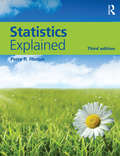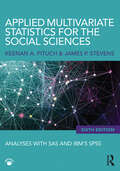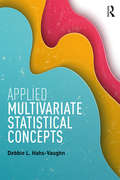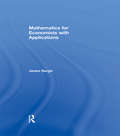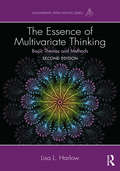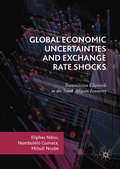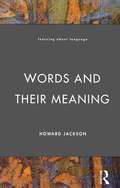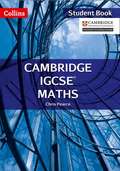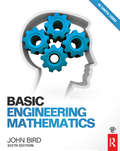- Table View
- List View
A Guide to Doing Statistics in Second Language Research Using SPSS and R (Second Language Acquisition Research Series)
by Jenifer Larson-HallA Guide to Doing Statistics in Second Language Research Using SPSS and R, Second Edition is the only text available that demonstrates how to use SPSS and R as specifically related to applied linguistics and SLA research. This new edition is up-to-date with the most recent version of the SPSS software and now also includes coverage of R, a software program increasingly used by researchers in this field. Supported by a number of pedagogical features, including tip boxes and practice activities, and a wealth of screenshots, this book takes readers through each step of performing and understanding statistical research, covering the most commonly used tests in second language research, including t-tests, correlation, and ANOVA. A robust accompanying website covers additional tests of interest to students and researchers, taking them step-by-step through carrying out these tests themselves. In this comprehensive and hands-on volume, Jenifer Larson-Hall equips readers with a thorough understanding and the practical skills necessary to conducting and interpreting statisical research effectively using SPSS and R, ideal for graduate students and researchers in SLA, social sciences, and applied lingustics. For more information and materials, please visit www.routledge.com/cw/larson-hall.
An Introduction to Psychological Tests and Scales
by Kate Loewenthal Christopher Alan LewisIn its first edition this book successfully enabled readers, with little or no prior knowledge of computing or statistics, to develop reliable and valid tests and scales for assessment or research purposes. In this edition, the author has thoroughly updated the text to include new recent advances in computer software and provide information on relevant internet resources. The book contains detailed guidelines for locating and constructing psychological measures, including descriptions of popular psychological measures and step-by-step instructions for composing a measure, entering data and computing reliability and validity of test results. Advanced techniques such as factor analysis, analysis of covariance and multiple regression analysis are presented for the beginner.An Introduction to Psychological Tests and Scales provides a clear, concise and jargon-free primer for all those embarking in fieldwork or research analysis. It will be an invaluable tool for undergraduates and postgraduates in psychology and a useful text for students and professionals in related disciplines.
An Introduction to Psychological Tests and Scales
by Kate Loewenthal Christopher Alan LewisIn its first edition this book successfully enabled readers, with little or no prior knowledge of computing or statistics, to develop reliable and valid tests and scales for assessment or research purposes. In this edition, the author has thoroughly updated the text to include new recent advances in computer software and provide information on relevant internet resources. The book contains detailed guidelines for locating and constructing psychological measures, including descriptions of popular psychological measures and step-by-step instructions for composing a measure, entering data and computing reliability and validity of test results. Advanced techniques such as factor analysis, analysis of covariance and multiple regression analysis are presented for the beginner.An Introduction to Psychological Tests and Scales provides a clear, concise and jargon-free primer for all those embarking in fieldwork or research analysis. It will be an invaluable tool for undergraduates and postgraduates in psychology and a useful text for students and professionals in related disciplines.
Statistics Explained
by Perry R. HintonStatistics Explained is an accessible introduction to statistical concepts and ideas. It makes few assumptions about the reader’s statistical knowledge, carefully explaining each step of the analysis and the logic behind it. The book: provides a clear explanation of statistical analysis and the key statistical tests employed in analysing research data gives accessible explanations of how and why statistical tests are used includes a wide range of practical, easy-to-understand worked examples. Building on the international success of earlier editions, this fully updated revision includes developments in statistical analysis, with new sections explaining concepts such as bootstrapping and structural equation modelling. A new chapter - ‘Samples and Statistical Inference’ - explains how data can be analysed in detail to examine its suitability for certain statistical tests. The friendly and straightforward style of the text makes it accessible to all those new to statistics, as well as more experienced students requiring a concise guide. It is suitable for students and new researchers in disciplines including Psychology, Education, Sociology, Sports Science, Nursing, Communication, and Media and Business Studies. Presented in full colour and with an updated, reader-friendly layout, this new edition also comes with a companion website featuring supplementary resources for students. Unobtrusive cross-referencing makes it the ideal companion to Perry R. Hinton’s SPSS Explained, also published by Routledge. Perry R. Hinton has many years of experience in teaching statistics to students from a wide range of disciplines and his understanding of the problems students face forms the basis of this book.
Statistics Explained
by Perry R. HintonStatistics Explained is an accessible introduction to statistical concepts and ideas. It makes few assumptions about the reader’s statistical knowledge, carefully explaining each step of the analysis and the logic behind it. The book: provides a clear explanation of statistical analysis and the key statistical tests employed in analysing research data gives accessible explanations of how and why statistical tests are used includes a wide range of practical, easy-to-understand worked examples. Building on the international success of earlier editions, this fully updated revision includes developments in statistical analysis, with new sections explaining concepts such as bootstrapping and structural equation modelling. A new chapter - ‘Samples and Statistical Inference’ - explains how data can be analysed in detail to examine its suitability for certain statistical tests. The friendly and straightforward style of the text makes it accessible to all those new to statistics, as well as more experienced students requiring a concise guide. It is suitable for students and new researchers in disciplines including Psychology, Education, Sociology, Sports Science, Nursing, Communication, and Media and Business Studies. Presented in full colour and with an updated, reader-friendly layout, this new edition also comes with a companion website featuring supplementary resources for students. Unobtrusive cross-referencing makes it the ideal companion to Perry R. Hinton’s SPSS Explained, also published by Routledge. Perry R. Hinton has many years of experience in teaching statistics to students from a wide range of disciplines and his understanding of the problems students face forms the basis of this book.
Applied Multivariate Statistics for the Social Sciences: Analyses with SAS and IBM’s SPSS, Sixth Edition
by James P. Stevens Keenan A. PituchNow in its 6th edition, the authoritative textbook Applied Multivariate Statistics for the Social Sciences, continues to provide advanced students with a practical and conceptual understanding of statistical procedures through examples and data-sets from actual research studies. With the added expertise of co-author Keenan Pituch (University of Texas-Austin), this 6th edition retains many key features of the previous editions, including its breadth and depth of coverage, a review chapter on matrix algebra, applied coverage of MANOVA, and emphasis on statistical power. In this new edition, the authors continue to provide practical guidelines for checking the data, assessing assumptions, interpreting, and reporting the results to help students analyze data from their own research confidently and professionally. Features new to this edition include: NEW chapter on Logistic Regression (Ch. 11) that helps readers understand and use this very flexible and widely used procedure NEW chapter on Multivariate Multilevel Modeling (Ch. 14) that helps readers understand the benefits of this "newer" procedure and how it can be used in conventional and multilevel settings NEW Example Results Section write-ups that illustrate how results should be presented in research papers and journal articles NEW coverage of missing data (Ch. 1) to help students understand and address problems associated with incomplete data Completely re-written chapters on Exploratory Factor Analysis (Ch. 9), Hierarchical Linear Modeling (Ch. 13), and Structural Equation Modeling (Ch. 16) with increased focus on understanding models and interpreting results NEW analysis summaries, inclusion of more syntax explanations, and?reduction in the number of SPSS/SAS dialogue boxes to guide students through data analysis in a more streamlined and direct approach Updated syntax to reflect newest versions of IBM SPSS (21) /SAS (9.3) A free online resources site at www.routledge.com/9780415836661 with data sets and syntax from the text, additional data sets, and instructor’s resources (including PowerPoint lecture slides for select chapters, a conversion guide for 5th edition adopters, and answers to exercises). Ideal for advanced graduate-level courses in education, psychology, and other social sciences in which multivariate statistics, advanced statistics, or quantitative techniques courses are taught, this book also appeals to practicing researchers as a valuable reference. Pre-requisites include a course on factorial ANOVA and covariance; however, a working knowledge of matrix algebra is not assumed.
Applied Multivariate Statistical Concepts
by Debbie L. Hahs-VaughnMore comprehensive than other texts, this new book covers the classic and cutting edge multivariate techniques used in today’s research. Ideal for courses on multivariate statistics/analysis/design, advanced statistics or quantitative techniques taught in psychology, education, sociology, and business, the book also appeals to researchers with no training in multivariate methods. Through clear writing and engaging pedagogy and examples using real data, Hahs-Vaughn walks students through the most used methods to learn why and how to apply each technique. A conceptual approach with a higher than usual text-to-formula ratio helps reader’s master key concepts so they can implement and interpret results generated by today’s sophisticated software. Annotated screenshots from SPSS and other packages are integrated throughout. Designed for course flexibility, after the first 4 chapters, instructors can use chapters in any sequence or combination to fit the needs of their students. Each chapter includes a ‘mathematical snapshot’ that highlights the technical components of each procedure, so only the most crucial equations are included. Highlights include: -Outlines, key concepts, and vignettes related to key concepts preview what’s to come in each chapter -Examples using real data from education, psychology, and other social sciences illustrate key concepts -Extensive coverage of assumptions including tables, the effects of their violation, and how to test for each technique -Conceptual, computational, and interpretative problems mirror the real-world problems students encounter in their studies and careers -A focus on data screening and power analysis with attention on the special needs of each particular method -Instructions for using SPSS via screenshots and annotated output along with HLM, Mplus, LISREL, and G*Power where appropriate, to demonstrate how to interpret results -Templates for writing research questions and APA-style write-ups of results which serve as models -Propensity score analysis chapter that demonstrates the use of this increasingly popular technique -A review of matrix algebra for those who want an introduction (prerequisites include an introduction to factorial ANOVA, ANCOVA, and simple linear regression, but knowledge of matrix algebra is not assumed) -www.routledge.com/9780415842365 provides the text’s datasets preformatted for use in SPSS and other statistical packages for readers, as well as answers to all chapter problems, Power Points, and test items for instructors ?
Mathematics for Economists with Applications
by James BerginMathematics for Economists with Applications provides detailed coverage of the mathematical techniques essential for undergraduate and introductory graduate work in economics, business and finance. Beginning with linear algebra and matrix theory, the book develops the techniques of univariate and multivariate calculus used in economics, proceeding to discuss the theory of optimization in detail. Integration, differential and difference equations are considered in subsequent chapters. Uniquely, the book also features a discussion of statistics and probability, including a study of the key distributions and their role in hypothesis testing. Throughout the text, large numbers of new and insightful examples and an extensive use of graphs explain and motivate the material. Each chapter develops from an elementary level and builds to more advanced topics, providing logical progression for the student, and enabling instructors to prescribe material to the required level of the course. With coverage substantial in depth as well as breadth, and including a companion website at www.routledge.com/cw/bergin, containing exercises related to the worked examples from each chapter of the book, Mathematics for Economists with Applications contains everything needed to understand and apply the mathematical methods and practices fundamental to the study of economics.
The Essence of Multivariate Thinking: Basic Themes and Methods
by Lisa L. HarlowBy focusing on underlying themes, this book helps readers better understand the connections between multivariate methods. For each method the author highlights: the similarities and differences between the methods, when they are used and the questions they address, the key assumptions and equations, and how to interpret the results. The concepts take center stage while formulas are kept to a minimum. Examples using the same data set give readers continuity so they can more easily apply the concepts. Each method is also accompanied by a worked out example, SPSS and SAS input, and an example of how to write up the results. EQS code is used for the book’s SEM applications. ?This extensively revised edition features: New SEM chapters including an introduction (ch.10), path analysis (ch.11), confirmatory factor analysis (ch.12), and latent variable modeling (ch.13) the last three with an EQS application. A new chapter on multilevel modeling (ch. 8) that is now used more frequently in the social sciences. More emphasis on significance tests, effect sizes, and confidence intervals to encourage readers to adopt a thorough approach to assessing the magnitude of their findings. A new data set that explores the work environment. More discussion about the basic assumptions and equations for each method for a more accessible approach. New examples that help clarify the distinctions between methods. A new website at https://sites.google.com/site/multivariatesecondedition/ that features the datasets for all of the examples in the book for use in both SPSS and SAS and in EQS for the SEM chapters. The first two chapters review the core themes that run through most multivariate methods. The author shows how understanding multivariate methods is much more achievable when we notice the themes that underlie these statistical techniques. This multiple level approach also provides greater reliability and validity in our research. After providing insight into the core themes, the author illustrates them as they apply to the most popular multivariate methods used in the social, and behavioral sciences. First, two intermediate methods are explored – multiple regression and analysis of covariance. Next the multivariate grouping variable methods of multivariate analysis of variance, discriminant function analysis, and logistic regression are explored. Next the themes are applied to multivariate modeling methods including multilevel modeling, path analysis, confirmatory factor analysis, and latent variable models that include exploratory structural methods of principal component and factor analysis. The book concludes with a summary of the common themes and how they pertain to each method discussed in this book. ?Intended for advanced undergraduate and/or graduate courses in multivariate statistics taught in psychology, education, human development, business, nursing, and other social and life sciences, researchers also appreciate this book‘s applied approach. Knowledge of basic statistics, research methods, basic algebra, and finite mathematics is recommended.
The Essence of Multivariate Thinking: Basic Themes and Methods
by Lisa L. HarlowBy focusing on underlying themes, this book helps readers better understand the connections between multivariate methods. For each method the author highlights: the similarities and differences between the methods, when they are used and the questions they address, the key assumptions and equations, and how to interpret the results. The concepts take center stage while formulas are kept to a minimum. Examples using the same data set give readers continuity so they can more easily apply the concepts. Each method is also accompanied by a worked out example, SPSS and SAS input, and an example of how to write up the results. EQS code is used for the book’s SEM applications. ?This extensively revised edition features: New SEM chapters including an introduction (ch.10), path analysis (ch.11), confirmatory factor analysis (ch.12), and latent variable modeling (ch.13) the last three with an EQS application. A new chapter on multilevel modeling (ch. 8) that is now used more frequently in the social sciences. More emphasis on significance tests, effect sizes, and confidence intervals to encourage readers to adopt a thorough approach to assessing the magnitude of their findings. A new data set that explores the work environment. More discussion about the basic assumptions and equations for each method for a more accessible approach. New examples that help clarify the distinctions between methods. A new website at https://sites.google.com/site/multivariatesecondedition/ that features the datasets for all of the examples in the book for use in both SPSS and SAS and in EQS for the SEM chapters. The first two chapters review the core themes that run through most multivariate methods. The author shows how understanding multivariate methods is much more achievable when we notice the themes that underlie these statistical techniques. This multiple level approach also provides greater reliability and validity in our research. After providing insight into the core themes, the author illustrates them as they apply to the most popular multivariate methods used in the social, and behavioral sciences. First, two intermediate methods are explored – multiple regression and analysis of covariance. Next the multivariate grouping variable methods of multivariate analysis of variance, discriminant function analysis, and logistic regression are explored. Next the themes are applied to multivariate modeling methods including multilevel modeling, path analysis, confirmatory factor analysis, and latent variable models that include exploratory structural methods of principal component and factor analysis. The book concludes with a summary of the common themes and how they pertain to each method discussed in this book. ?Intended for advanced undergraduate and/or graduate courses in multivariate statistics taught in psychology, education, human development, business, nursing, and other social and life sciences, researchers also appreciate this book‘s applied approach. Knowledge of basic statistics, research methods, basic algebra, and finite mathematics is recommended.
Mathematics for Scientific and Technical Students
by H. Davies H. G. Davies G. A. HicksThis new edition provides a full introduction to the mathematics required for all technical subjects, particularly engineering. It has been completely updated and is designed to bring the student up to the required mathematical knowledge for their course.
Global Economic Uncertainties and Exchange Rate Shocks: Transmission Channels to the South African Economy
by Eliphas Ndou Nombulelo Gumata Mthuli NcubeThis book examines the macroeconomic and regulatory impact of domestic and international shocks on the South African economy resulting from the 2009 financial crisis. It also assesses the impact of the US economy’s eventual recovery from the crisis and the prospect of higher US interest rates in future. Told in three parts, the book explores associations between economic growth, policy uncertainty and the key domestic and international transmission channels, and transmission effects, of global financial regulatory and domestic macro-economic uncertainties on subdued and volatile economic recovery, financial channels, lending rate margins, and credit growth. The book concludes by extending its focus to the role of US monetary policy, capital flows and rand/US dollar volatility on the South African economy.
Global Economic Uncertainties and Exchange Rate Shocks: Transmission Channels to the South African Economy
by Eliphas Ndou Nombulelo Gumata Mthuli NcubeThis book examines the macroeconomic and regulatory impact of domestic and international shocks on the South African economy resulting from the 2009 financial crisis. It also assesses the impact of the US economy’s eventual recovery from the crisis and the prospect of higher US interest rates in future. Told in three parts, the book explores associations between economic growth, policy uncertainty and the key domestic and international transmission channels, and transmission effects, of global financial regulatory and domestic macro-economic uncertainties on subdued and volatile economic recovery, financial channels, lending rate margins, and credit growth. The book concludes by extending its focus to the role of US monetary policy, capital flows and rand/US dollar volatility on the South African economy.
OCR A Level Further Mathematics Core Year 1 (AS)
by Ben Sparks Claire BaldwinGrow your students' confidence in applying mathematical techniques to solving problems with resources developed specifically for the OCR specification subject experts and in conjunction with MEI (Mathematics in Education and Industry).
Maths for the Building Trades
by Jim Kidd Ian BellMaths for the Building Trades provides students of all ages with an easy-to-understand guide to the fundamental mathematics that is required in their area of study and beyond. It can be used as a learning programme on its own or in conjunction with the textbooks associated with their chosen trade.The book assumes only a minimum level of mathematical knowledge and thoroughly covers the basic rules. It then goes on to fully explain some of the more complex areas in which the student will be required to demonstrate competence.
Maths for the Building Trades
by Jim Kidd Ian BellMaths for the Building Trades provides students of all ages with an easy-to-understand guide to the fundamental mathematics that is required in their area of study and beyond. It can be used as a learning programme on its own or in conjunction with the textbooks associated with their chosen trade.The book assumes only a minimum level of mathematical knowledge and thoroughly covers the basic rules. It then goes on to fully explain some of the more complex areas in which the student will be required to demonstrate competence.
Words and Their Meaning
by Howard JacksonIn this book, the development of the English dictionary is examined, along with the kinds of dictionary available, the range of information they contain, factors affecting their usage, and public attitudes towards them. As well as an descriptive analysis of word meaning, the author considers whether a thematic, thesaurus-like presentation might be more suited than the traditional alphabetical format to the description of words and their meaning.
Words and Their Meaning
by Howard JacksonIn this book, the development of the English dictionary is examined, along with the kinds of dictionary available, the range of information they contain, factors affecting their usage, and public attitudes towards them. As well as an descriptive analysis of word meaning, the author considers whether a thematic, thesaurus-like presentation might be more suited than the traditional alphabetical format to the description of words and their meaning.
Cambridge iGCSE Maths Student Book (PDF)
by Chris PearceCollins Cambridge IGCSE Maths Student Book - Second Edition provides in-depth coverage of every aspect of the latest Cambridge IGCSE Mathematics 0580 syllabus for examination from 2015 onwards. We are working with Cambridge International Examinations towards endorsement of this title. The resource covers the Core and Extended curriculum. * Support and challenge students with the Core curriculum and Extended curriculum together in one book. This also aids transition from Core to Extended. * Help students to prepare for examination with Cambridge questions from previous papers. * Develop problem solving with flagged questions that require students to apply their skills, often in real life, international contexts. * Cover the curriculum with confidence with clear references to what students will learn at the start of every chapter. * See what level students are working at with all questions labelled Core or Extended. * Emphasise the relevance of maths with 'Why this chapter matters' showing maths in everyday life or historical development. * Consolidate understanding with tried and tested questions in extensive practice exercises and detailed worked examples. * Deliver a fully international course with international examples, contexts, names, currency and locations. * Encourage students to check their work with answers to all exercise questions at the back of the book. Examination answers are only available in the Teacher's Pack. IGCSE is the registered trademark of Cambridge International Examinations.
R Data Analysis without Programming
by David W. GerbingThis book prepares readers to analyze data and interpret statistical results using R more quickly than other texts. R is a challenging program to learn because code must be created to get started. To alleviate that challenge, Professor Gerbing developed lessR. LessR extensions remove the need to program. By introducing R through less R, readers learn how to organize data for analysis, read the data into R, and produce output without performing numerous functions and programming exercises first. With lessR, readers can select the necessary procedure and change the relevant variables without programming. The text reviews basic statistical procedures with the lessR enhancements added to the standard R environment. Through the use of lessR, R becomes immediately accessible to the novice user and easier to use for the experienced user. Highlights of the book include: Quick Starts that introduce readers to the concepts and commands reviewed in the chapters. Margin notes that highlight,define,illustrate,and cross-reference the key concepts.When readers encounter a term previously discussed, the margin notes identify the page number to the initial introduction. Scenarios that highlight the use of a specific analysis followed by the corresponding R/lessR input and an interpretation of the resulting output. Numerous examples of output from psychology, business, education, and other social sciences, that demonstrate how to interpret results. Two data sets provided on the website and analyzed multiple times in the book, provide continuity throughout. End of chapter worked problems help readers test their understanding of the concepts. A website at www.lessRstats.com that features the lessR program, the book’s data sets referenced in standard text and SPSS formats so readers can practice using R/lessR by working through the text examples and worked problems, PDF slides for each chapter, solutions to the book’s worked problems, links to R/lessR videos to help readers better understand the program, and more. An ideal supplement for graduate or advanced undergraduate courses in statistics, research methods, or any course in which R is used, taught in departments of psychology, business, education, and other social and health sciences, this book is also appreciated by researchers interested in using R for their data analysis. Prerequisites include basic statistical knowledge. Knowledge of R is not assumed.
R Data Analysis without Programming
by David W. GerbingThis book prepares readers to analyze data and interpret statistical results using R more quickly than other texts. R is a challenging program to learn because code must be created to get started. To alleviate that challenge, Professor Gerbing developed lessR. LessR extensions remove the need to program. By introducing R through less R, readers learn how to organize data for analysis, read the data into R, and produce output without performing numerous functions and programming exercises first. With lessR, readers can select the necessary procedure and change the relevant variables without programming. The text reviews basic statistical procedures with the lessR enhancements added to the standard R environment. Through the use of lessR, R becomes immediately accessible to the novice user and easier to use for the experienced user. Highlights of the book include: Quick Starts that introduce readers to the concepts and commands reviewed in the chapters. Margin notes that highlight,define,illustrate,and cross-reference the key concepts.When readers encounter a term previously discussed, the margin notes identify the page number to the initial introduction. Scenarios that highlight the use of a specific analysis followed by the corresponding R/lessR input and an interpretation of the resulting output. Numerous examples of output from psychology, business, education, and other social sciences, that demonstrate how to interpret results. Two data sets provided on the website and analyzed multiple times in the book, provide continuity throughout. End of chapter worked problems help readers test their understanding of the concepts. A website at www.lessRstats.com that features the lessR program, the book’s data sets referenced in standard text and SPSS formats so readers can practice using R/lessR by working through the text examples and worked problems, PDF slides for each chapter, solutions to the book’s worked problems, links to R/lessR videos to help readers better understand the program, and more. An ideal supplement for graduate or advanced undergraduate courses in statistics, research methods, or any course in which R is used, taught in departments of psychology, business, education, and other social and health sciences, this book is also appreciated by researchers interested in using R for their data analysis. Prerequisites include basic statistical knowledge. Knowledge of R is not assumed.
Higher Engineering Mathematics, 7th ed
by John BirdA practical introduction to the core mathematics principles required at higher engineering level John Bird’s approach to mathematics, based on numerous worked examples and interactive problems, is ideal for vocational students that require an advanced textbook. Theory is kept to a minimum, with the emphasis firmly placed on problem-solving skills, making this a thoroughly practical introduction to the advanced mathematics engineering that students need to master. The extensive and thorough topic coverage makes this an ideal text for upper level vocational courses. Now in its seventh edition, Engineering Mathematics has helped thousands of students to succeed in their exams. The new edition includes a section at the start of each chapter to explain why the content is important and how it relates to real life. It is also supported by a fully updated companion website with resources for both students and lecturers. It has full solutions to all 1900 further questions contained in the 269 practice exercises.
Engineering Mathematics, 7th ed
by John BirdA practical introduction to the core mathematics required for engineering study and practice Now in its seventh edition, Engineering Mathematics is an established textbook that has helped thousands of students to succeed in their exams. John Bird's approach is based on worked examples and interactive problems. This makes it ideal for students from a wide range of academic backgrounds as the student can work through the material at their own pace. Mathematical theories are explained in a straightforward manner, being supported by practical engineering examples and applications in order to ensure that readers can relate theory to practice. The extensive and thorough topic coverage makes this an ideal text for a range of Level 2 and 3 engineering courses.This title is supported by a companion website with resources for both students and lecturers, including lists of essential formulae, multiple choice tests, full solutions for all 1,800 further questions contained within the practice exercises, and biographical information on the 24 famous mathematicians and engineers referenced throughout the book. The companion website for this title can be accessed from www.routledge.com/cw/bird
Engineering Mathematics, 7th ed
by John BirdA practical introduction to the core mathematics required for engineering study and practice Now in its seventh edition, Engineering Mathematics is an established textbook that has helped thousands of students to succeed in their exams. John Bird's approach is based on worked examples and interactive problems. This makes it ideal for students from a wide range of academic backgrounds as the student can work through the material at their own pace. Mathematical theories are explained in a straightforward manner, being supported by practical engineering examples and applications in order to ensure that readers can relate theory to practice. The extensive and thorough topic coverage makes this an ideal text for a range of Level 2 and 3 engineering courses.This title is supported by a companion website with resources for both students and lecturers, including lists of essential formulae, multiple choice tests, full solutions for all 1,800 further questions contained within the practice exercises, and biographical information on the 24 famous mathematicians and engineers referenced throughout the book. The companion website for this title can be accessed from www.routledge.com/cw/bird
Basic Engineering Mathematics, 6th ed
by John BirdIntroductory mathematics written specifically for students new to engineering Now in its sixth edition, Basic Engineering Mathematics is an established textbook that has helped thousands of students to succeed in their exams. John Bird's approach is based on worked examples and interactive problems. This makes it ideal for students from a wide range of academic backgrounds as the student can work through the material at their own pace. Mathematical theories are explained in a straightforward manner, being supported by practical engineering examples and applications in order to ensure that readers can relate theory to practice. The extensive and thorough topic coverage makes this an ideal text for introductory level engineering courses. This title is supported by a companion website with resources for both students and lecturers, including lists of essential formulae, multiple choice tests, full solutions for all 1,600 further questions contained within the practice exercises, and biographical information on the 25 famous mathematicians and engineers referenced throughout the book. The companion website for this title can be accessed from www.routledge.com/cw/bird


